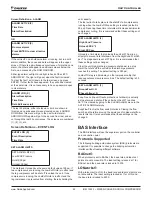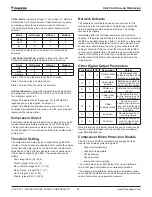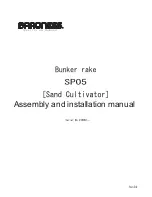
Unit Maintenance
www.DaikinApplied.com 69
IOM 1322-1 • WATER-COOLED SCROLL COMPRESSOR
Sight Glass and Moisture Indicator
The refrigerant sight glasses should be observed periodically.
A monthly observation should be adequate. A clear glass of
liquid indicates that there is adequate refrigerant charge in the
system to provide proper feed through the expansion valve.
The sight glass should be clear when:
• Ambient temperature is above 75°F (23°C)
• Both compressors on a circuit are running
• All fans on a circuit are running
Bubbling refrigerant in the sight glass may occur at other
conditions and may indicate that the system is short of
refrigerant charge. Refrigerant gas flashing in the sight glass
could also indicate an excessive pressure drop in the line,
possibly due to a clogged filter-drier or a restriction elsewhere
in the system. An element inside the sight glass indicates what
moisture condition corresponds to a given element color. If
the sight glass does not indicate a dry condition after about 12
hours of operation, the unit should be pumped down, the filter
driers changed, and oil sample should be tested for acid.
If the system is suspected of being short of refrigerant, a
qualified service technician with EPA certification should be
contacted to thoroughly check out the unit and add refrigerant
if necessary.
Crankcase Heaters
The compressors are equipped with crankcase heaters.
The function of the heater is to keep the temperature in the
crankcase high enough to prevent refrigerant from migrating
to the crankcase and condensing in the oil during off-cycle.
When a system is to be started up initially, the power to the
heaters should be turned on for at least 12 hours before the
compressors are started. The crankcase should be up to
about 80°F (26.7°C) before the system is started, to minimize
lubrication problems or liquid slugging of compressor. If the
crankcase is cool (below 80°F) (26.7°C) and the oil level in
the sight glass is full to top, allow more time for oil to warm
before starting the compressor. The crankcase heaters are on
whenever power is supplied to the unit and the compressor is
not running.
Phase/Voltage Monitor (Optional)
The phase/voltage monitor is a device that provides protection
against three-phase electrical motor loss due to power failure
conditions, phase loss, under/over voltage, and phase reversal.
Whenever any of these conditions occur, an input relay is
deactivated, disconnecting power to the thermostatic control
circuit. The compressor does a rapid shutdown pump down.
The input relay remains deactivated until power line conditions
return to an acceptable level. Trip and reset delays prevent
nuisance tripping due to rapid power fluctuations.
When three-phase power has been applied, the input relay
should close and the “run light” should come on. If the relay
does not close, perform the following tests.
1. 1 Check the voltages between L1-L2, L1-L3, and L2-L3.
Voltages should be approximately equal and 10%
of the rated three-phase line-to-line voltage.
2. If these voltages are extremely low or widely unbalanced,
check the power system to determine the cause of the
problem.
3. Verify phasing with a phase sequence meter before
changing any leads.
Factory settings are as follows:
• Voltage Setting: set at nameplate voltage.
• Trip Delay Time: 2 seconds
• Restart Delay Time: 60 seconds
Hot Gas Bypass (Optional)
This option allows passage of discharge gas to the evaporator,
permitting operation at lower loads than available with
compressor unloading. It also keeps the velocity of refrigerant
gas high enough for proper oil return at light load conditions
The pressure regulating valve is set to begin opening at 97
psig (665 kPa) and can be changed by changing the pressure
setting. The adjustment range is 75 to 150 psig. To raise
the pressure setting, remove the cap on the bulb and turn
the adjustment screw clockwise. To lower the setting, turn
the screw counterclockwise. Do not force the adjustment
beyond the range it is designed for, as this will damage the
adjustment assembly. The regulating valve opening point
can be determined by slowly reducing the system load while
observing the suction pressure. When the bypass valve starts
to open, the refrigerant line on the evaporator side of the valve
will begin to feel warm to the touch.
CAUTION
The hot gas line can become hot enough to cause personal injury in a very
short time. Avoid contact when it is operating or during cool-down period.
Summary of Contents for IOM 1322-1
Page 4: ......
Page 57: ...Unit Controller Operation www DaikinApplied com 57 IOM 1322 1 WATER COOLED SCROLL COMPRESSOR...
Page 71: ...Unit Maintenance www DaikinApplied com 71 IOM 1322 1 WATER COOLED SCROLL COMPRESSOR...
Page 74: ...IOM 1322 1 WATER COOLED SCROLL COMPRESSOR 74 www DaikinApplied com Troubleshooting Chart...
Page 75: ...Troubleshooting Chart www DaikinApplied com 75 IOM 1322 1 WATER COOLED SCROLL COMPRESSOR...
Page 76: ...IOM 1322 1 WATER COOLED SCROLL COMPRESSOR 76 www DaikinApplied com Troubleshooting Chart...
Page 77: ...Troubleshooting Chart www DaikinApplied com 77 IOM 1322 1 WATER COOLED SCROLL COMPRESSOR...
Page 78: ...IOM 1322 1 WATER COOLED SCROLL COMPRESSOR 78 www DaikinApplied com Troubleshooting Chart...












































